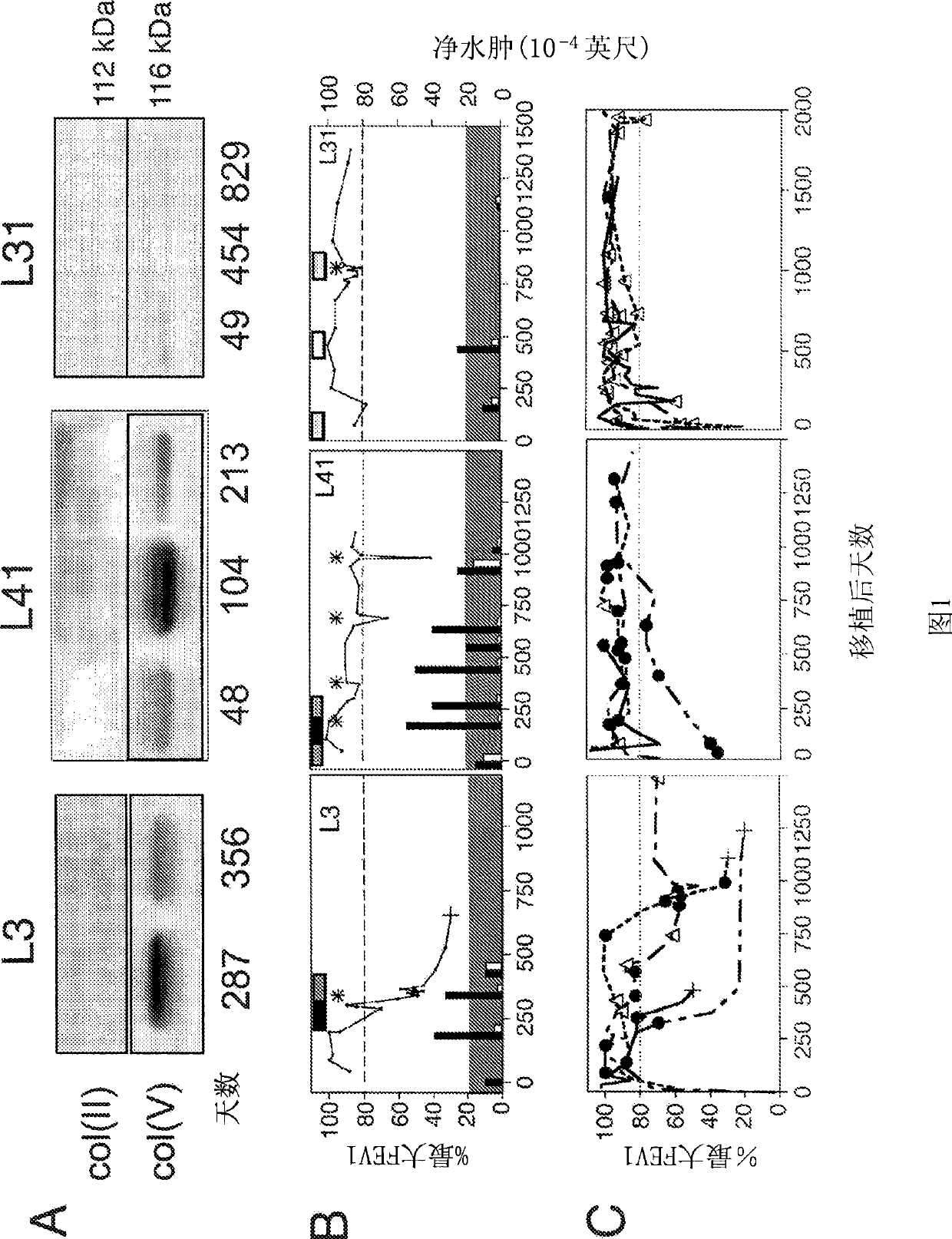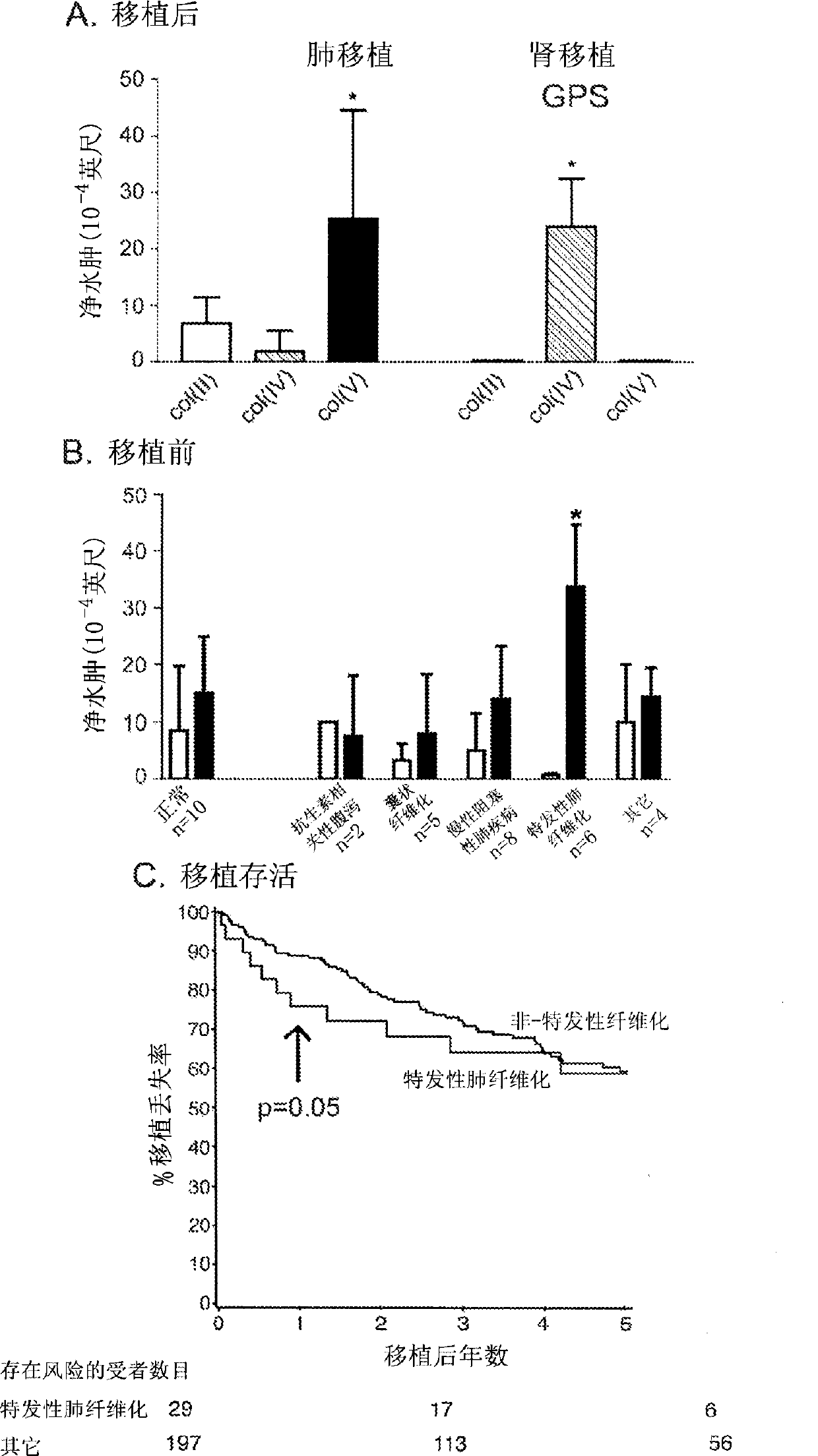Molecules for the treatment of lung disease involving an immune reaction to connective tissue found in the lung
An autoimmune and disease technology, applied in the fields of disease diagnosis, drug combination, analysis of materials, etc., can solve problems such as difficult diagnosis and treatment, unknown potential etiology, etc.
- Summary
- Abstract
- Description
- Claims
- Application Information
AI Technical Summary
Problems solved by technology
Method used
Image
Examples
Embodiment 2
[0080] An unexpected result of Example 2 was that patients diagnosed with or at risk of developing IPF could be treated prior to transplantation by restoring or enhancing self-tolerance to col(V). One embodiment is a method of treating IPF by enhancing the patient's response to collagen by oral therapy (Yasufuku et al. 2001; Yasufuku et al., 2002) into the lung space or by administering col(V) based on a desensitization strategy with a designed dosing regimen. Tolerance of proteins including but not limited to type V collagen and antigenic components and variants thereof.
[0081] Another embodiment is an antibody-based assay for the diagnosis and monitoring of diseases including autoimmune responses.
[0082] According to some embodiments, detecting the presence of collagen antibodies can be accomplished with any immunoassay procedure (eg, ELISA). Standard immunoassay textbooks can be found for numerous immunoassay procedures including, but not limited to, noncompetitive sin...
Embodiment 1
[0094] To determine whether patients after lung transplantation also develop autoimmunity specific to type V collagen, we performed a delayed-type hypersensitivity (DTH) assay using leukocytes from eight lung transplants and three different collagens recipient and 5 kidney transplant recipients with pulmonary hemorrhagic nephritic syndrome, an autoimmune disease of type V collagen (col). Such as image 3 As shown in column A, T cells from lung transplant recipients responded to col(V) but not to col(IV) or col(II), whereas T cells from patients with pulmonary hemorrhagic nephritic syndrome responded to col(IV ) had a significantly higher DTH response, but no response to col(V) or col(II). This important finding suggests that lung transplant patients have anti-collagen V autoimmunity.
[0095] We next determined whether an anti-collagen V autoimmune response could be seen in any patient awaiting lung transplantation and, if so, reflects a pre-existing condition that leads to ...
Embodiment 3
[0121]Microbead Assay for Detection of Humoral or Antibody-Mediated Anti-V Collagen Immune Responses. This method is used to detect antibodies to collagen V in the serum and / or lung lavage fluid of patients with autoimmune reactions to collagen V. The method also provides Type V collagen coated microbeads along with other necessary reagents. Serum and / or lung lavage fluid, and common reagents such as PBS may be provided to the end user, or these reagents may be assembled into a kit, to perform the assay. In short, a typical analysis is as follows:
[0122] 1) Streptavidin-coated microbeads (5um, binding capacity 10-20ug / 1×10 / 7 microbeads (Polyscience, Warrington, PA)) were washed twice with sterilized PBS. Microbeads (1×10 / 7) and 40ug human type V collagen were suspended in 100ul PBS and incubated at 4°C for 60 minutes.
[0123] 2) A 20um rabbit anti-human collagen type V antibody (bioten) (Abeam, Cambridge, MA) was used to prepare a positive control following the same proc...
PUM
| Property | Measurement | Unit |
|---|---|---|
| Sensitivity | aaaaa | aaaaa |
Abstract
Description
Claims
Application Information
 Login to View More
Login to View More - R&D Engineer
- R&D Manager
- IP Professional
- Industry Leading Data Capabilities
- Powerful AI technology
- Patent DNA Extraction
Browse by: Latest US Patents, China's latest patents, Technical Efficacy Thesaurus, Application Domain, Technology Topic, Popular Technical Reports.
© 2024 PatSnap. All rights reserved.Legal|Privacy policy|Modern Slavery Act Transparency Statement|Sitemap|About US| Contact US: help@patsnap.com










